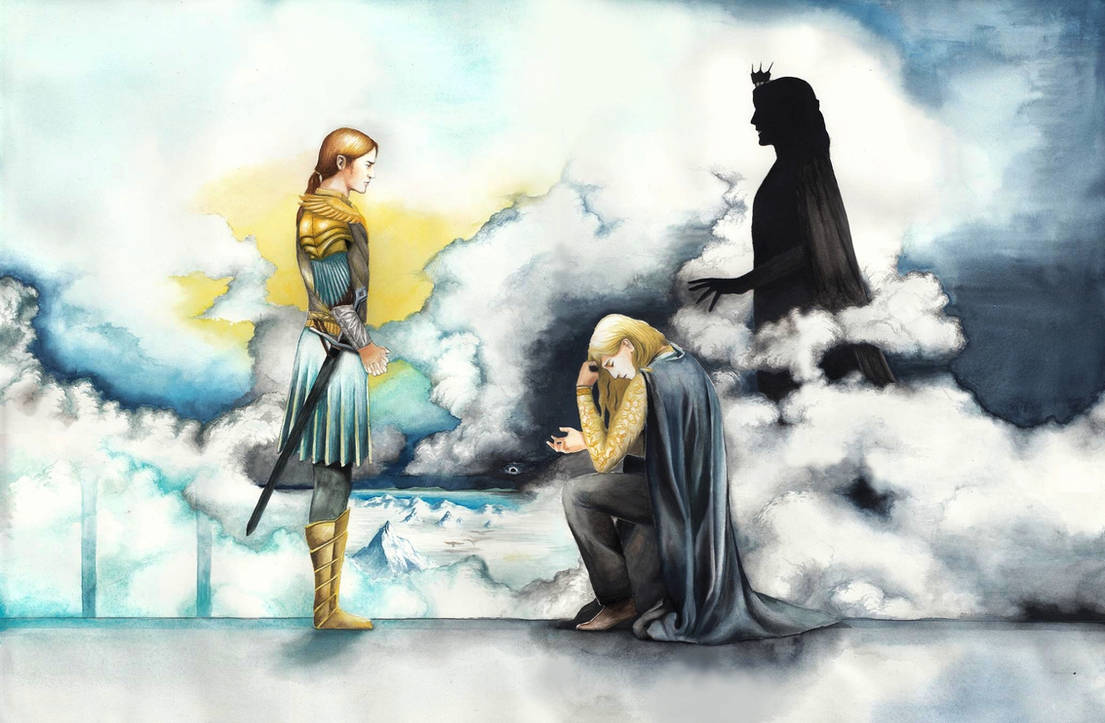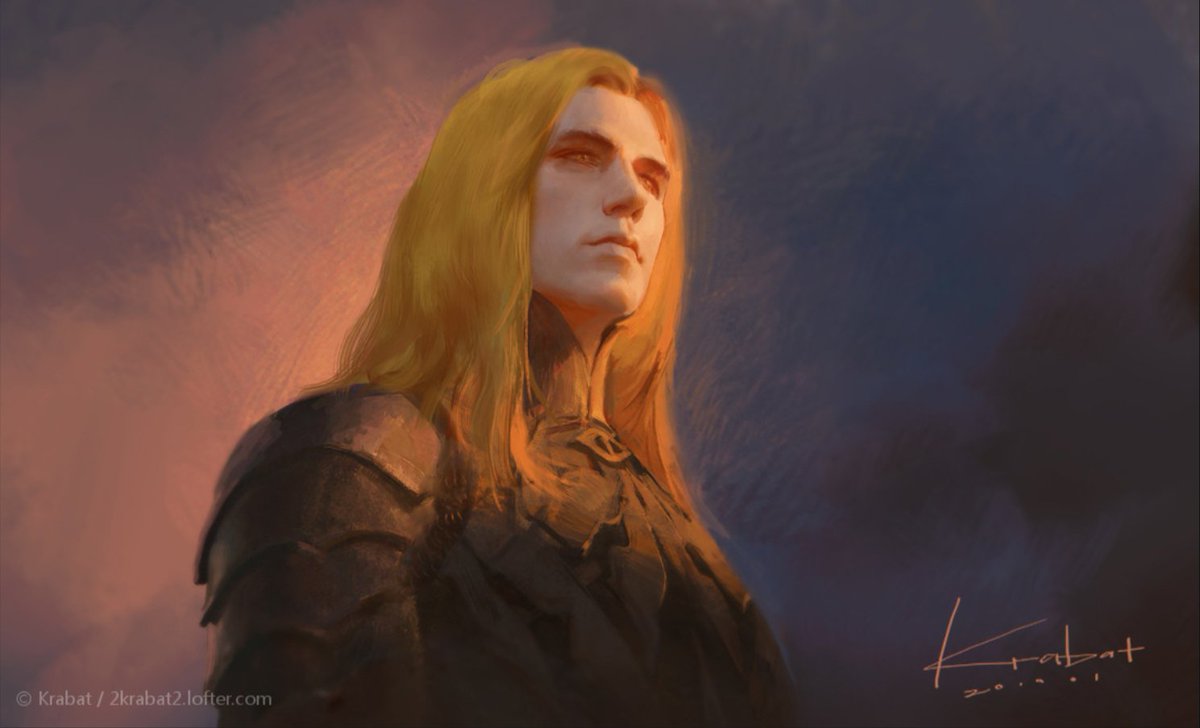With the end of The War of Wrath, Eönwë, the herald of Manwë, summoned the Elves of Beleriand to the West, so they were received in Tol Eressëa and under the pardon of the Valar. Most of the Noldor and Sindar did so, but a number of them did not and instead went east.
A Thread


Fëanáro@ffeanaro
Sep 15 22
View on Twitter
The War of Wrath - A Thread
The War of Wrath, also known as the Great Battle, was the final conflict in the Wars of Beleriand fought between the Host of the Valar and the Host of Morgoth at the end of the First Age, according to The War of the Jewels, it lasted for 42 years.
Maedhros and Maglor, the last of the sons of Fëanor, sent word to Eönwë to yield the Silmarils to them, but Eönwë replied that the Silmarils would not suffer them to hold them and that the brothers had to face judgment from the Valar in Aman.
Maglor was willing to listen, but Maedhros reminded Maglor that they had sworn that none, even the Valar, could release them from their oath.
So Maedhros and Maglor crept into the camp of Eönwë and stole the jewels. Though they were caught, Eönwë let them depart. Each brother took one jewel, but their bad deeds caused the holy Jewels to burn their hands.
Unable to endure the suffering and the pain, Maedhros killed himself, casting himself with the Silmaril into a fiery chasm of the Earth, and so becoming the first and only elf to commit suicide.
Maglor cast his Silmaril into the sea and never returned to his folk, instead wandering along the coast and lamenting his loss and pain.
Legend says that he still wanders the shores of the World, singing laments for his despair and regret. Thus, the Silmarils remained in all three realms of Arda — in the sky, beneath the earth, and within the sea.
Gil-galad founded a kingdom in Lindon in the far north-west of Middle-earth, roughly between the Blue Mountains and the Great Sea around the Gulf of Lhûn, and the havens of Forlond, Harlond, and Mithlond were founded.
Gil-galad was the last heir of the kings of the Noldor in exile, and acknowledged as High King of the Elves of the West. Many Elves, both the Sindar and the Noldor, joined him. But soon, there was again unrest among the Noldor, and many of them left Lindon.
Galadriel Being one of the chief leaders of the rebellion was not allowed to return and a ban was set upon her, to which she replied that she had no wish to do so.
The same pride that led her out of Aman still moved her, and she rejected the pardon of the Valar, for as she had once lived in Aman itself, Eressëa seemed only a second best. She was also moved by love for Celeborn, to whom she probably married around this time.
Celeborn and Galadriel dwelt for a time in Lindon, south of the Lune, while Gil-galad ruled in the north. Both left Lindon before the years 10-20, when Gil-galad became king in that land.
They entered Eriador and dwelt for a while around Lake Nenuial, being followed by many Noldor, Grey-elves, and Green-elves. Around S.A. 300 they were considered the Lord and Lady of the Eldar in Eriador.
The Edain were rewarded for fighting with the Valar in the war and were given a new land to dwell in that was neither part of Middle-earth nor of Valinor.
It was raised by Ossë out of the depths of the Great Water, and it was established by Aulë and enriched by Yavanna; and the Eldar brought thither flowers and fountains out of Tol Eressëa.
That land, the Valar called Andor, the Land of Gift; but the Edain named it Elenna and later Númenórë.
Most of the Men who fought in the armies of Morgoth were Easterlings, who came from the region around the Sea of Rhûn. Some Easterlings offered their services to the Elvish kingdoms in Beleriand, among them were Bór and his sons and Ulfang the Black and his sons.
This proved to be disastrous for the Free Peoples in the Nírnaeth Arnoediad when Ulfang and his clan switched sides and defected to Morgoth, while Bór and his sons died bravely fighting on the side of the Elves.
After the War of Wrath, those that survived fled back over the Blue Mountains to Eriador and beyond where they sat themselves up as kings and chieftains of many of the Middle Men.
The Dwarven cities Nogrod and Belegost were ruined when the Ered Luin were broken, forcing their populaces to flee.
Around S.A. 40, the Dwarves of the Blue Mountains began to migrate to Khazad-dûm, abandoning Nogrod and Belegost. However, there always remained some Dwarves on the eastern side of the Blue Mountains for days afterward.
With the downfall of Morgoth, Sauron, the former chief lieutenant of Morgoth adopted a fair form and came out to sue for Eönwë's pardon, repenting his evil deeds in fear of the wrath of the Valar.
Sauron was ordered by Eönwë to return to Valinor to receive judgment. Sauron was not willing to suffer such humiliation, so he instead fled and hid in Middle-earth.
The creatures that composed them were not eradicated, and many remained to trouble the world under the power of Sauron. The Orcs were nearly destroyed in the War of Wrath, and those that survived fled eastwards into the Mountains of Angmar, the Grey Mountains and the Red Mountain
The Balrogs also was nearly destroyed, save by one who fled and hid deep in the Misty Mountains, known by the title of Durin's Bane.
For thousands of years, he was awoken by the Dwarves of Moria in the Third Age, responsible for the death of King Durin VI and the ruin of Moria, he was later then killed by Gandalf.
Nearly all of the winged Fire-drakes were destroyed by Ëarendil, Thorondor, and his Eagles during the War of Wrath, but two fled, and the surviving drakes eventually started to multiply in the far north.
The name of these two dragons that survived is not said, but I believe it is Smaug and Scatha.
Smaug came down from the North and sacked the Lonely Mountain. Later, in T.A. 2941, Thrór's grandson Thorin returned with a small group to reclaim his grandfather's kingdom, he was later then slain by the Black Arrow shot by Bard the Bowman.
Little is known about Scatha, before his appearance in the Third Age. his lair was in the southern slopes of the Grey Mountains and he greatly troubled the Dwarves and Men living in the lands north of Wilderland and had stolen a great deal of their treasure.
He was slain by the Éothéod lord Fram, son of Frumgar (an ancestor of Eorl the Young) in the early days of the Éothéod (roughly T.A. 2000).
The Cold-drakes hid away north of Grey Mountains. As the millennia passed, their numbers grew, until they became a serious threat in the later centuries of the Third Age to the Dwarves that mined the Grey Mountains.
In T.A. 2589, Dáin I, King of Durin's Folk, and his second son Frór were slain at the gates of their halls by a Cold-drake.
The attacks of these fearsome creatures persuaded the Dwarves to migrate eastwards from the Grey Mountains, and it was soon afterward that their realms in the Iron Hills and at Erebor were established.
Morgoth himself remains in the Void, brooding in his hatred, watched by Eärendil and unable to return to Arda as long as the Valar maintain their power over it.
However, the lies he put in the hearts of the Children of Ilúvatar still remain and will create their evil results till the end of days. According to legend and prophecy, he will one day break through the Doors of Night and come upon Arda in great wrath, laying it to waste.
Morgoth's will was suffused into the matter of Arda, so in a sense he is never truly gone. Arda was marred by him so deeply that only Eru could fully repair the damage.
Those who wished to follow in Morgoth's footsteps, such as Sauron, found that by using his residual influence, they could easily corrupt the races they wished to dominate.

Fëanáro
@ffeanaro
"For Fëanor was made the mightiest in all parts of body and mind... of all the Children of Ilúvatar, and a bright flame was in him."
Missing some tweets in this thread? Or failed to load images or videos? You can try to .







































